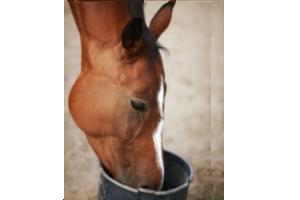The efficacy of live yeast in horses

Horses are trickle feeding herbivores, nomadic in nature and who have evolved to ingest small, fibre-rich meals on an almost continual basis. As hind gut fermenters, horses rely on a symbiotic relationship with bacteria and other gut flora, to digest the fibrous portion of their daily ration. Too much starch in the diet increases the risk of colic and laminitis. The addition of yeast to the diet may help in managing these problems.
By Catherine Hale, Equine
Research and Development
Manager, LFA Celtic, Ireland The digestive physiology of the modern horse is designed to ingest large quantities of forage each day. Indeed many horses and ponies can consume up to 4-5% of their BW in DM/day if fed ad libitum. As the horse does not ruminate, it relies on high chewing rates to mechanically breakdown the ingested food. Typical rates of mastication for horses consuming hay are around 3,500 chews per kg DM. However, despite the physiological capabilities of the equine gut, many domesticated horses are fed diets supplemented with concentrate, or sweet feed, in order to meet the energy demands placed upon them. Equidae (the horse family) are fairly inefficient at breaking down starch, when compared to other animals such as pigs. The natural diet of the horse would contain mainly grass species and therefore very little starch would be present. To that end, horses have lowered -amylase and brush-border glycanase production, thus limiting the efficacy of these enzymes when hydrolyzing any starch consumed. If small, starchrich meals are fed, then the horse will be unlikely to suffer any consequences of the reduced level of amylolytic enzymes. This is due to the lengthened mean retention time resulting from the small size of the meal. However, it is a fact, universally accepted by equine nutritionists, horse owners do appear to ignore advice regarding meal size, and often attempt to feed bucketful’s of feed.
Starch maximum
In an attempt to clarify the question of starch provision, many nutritionists advocate feeding a maximum of 1g starch/kg BW/meal. If starch is over fed, any undigested starch will pass from the small intestine into the hind gut. Just as with cattle, starch entering the rumen-equivalent fermentation chamber, the caecum, will be rapidly fermented by the bacteria which reside in this section of the intestine. As the starch is fermented in the caecum and colon, lactic acid is produced, thus leading to the onset of hind gut acidosis and the death of cellulolytic and hemicellulolytic bacteria. Allowing acidosis to persist can lead to problems such as caecal and colonic ulcers, colic and laminitis. Many performance or racing horses, with increased energy demands, will often be fed meals high in starch, thus resulting in a large proportion of these horses suffering from “starch dumping” into the hind gut. These horses will experience a drop in the pH of the caecum and a build-up of lactic acid, both of which will invariably lead to a loss of performance. Studies conducted, in vitro, looking at the effects of Saccharomyces cerevisiea NCYC Sc 47 (Actisaf, LFA) have found that supplementation with the yeast reduced lactic acid accumulation (Figure 1) and maintained a more stable pH, suggesting the yeast not only appeared to reduce the amount of lactic acid producing bacteria, but also seemed to also exert a buffeting effect (Figure 2). It is well documented that supplementation with live yeast will increase DM digestibility in horses. Until recently, this information was mainly based upon data for hay consumption. Recent research has found, however, that live yeast will also increase DM digestibility in haylage, red clover silage and high temperature dried lucerne (Warren & Hle, 2012).
Laminitis changes bacterial profile
One area that has not been investigated previously is that of the digestibility of hay or starch in horses with a history of laminitis. At the recent European Workshop on Equine Nutrition (EWEN), Hale et al., presented in vitro data that suggested bacteria taken from the faecal material of horses who had suffered laminitis in the past had a significantly lower fermentation rate compared to bacteria from normal horses when fed hay. This trend was completely reversed when comparing starch digestibility. Horses with a history of laminitis had a significantly higher rate and extent of fermentation compared to normal horses. This would appear to suggest that laminitic-prone horses have an altered bacterial profile, or dysfunctional microbiome. The most recent fi ndings in this area have compared the fermentation capacity of “normal” horses and “laminitic” (prone) horses, using the in vitro gas production technique, as used by Hale et al.,(2012). In this experiment, innocula was made with either faecal material from normal horses, or faecal material from horses with a history of laminitis. This was then used to incubate the following substrates: hay; hay plus yeast; starch; and starch plus yeast. Saccharomyces cerevisiea NCYC Sc 47 was the yeast used. The results showed that the Sc 47 yeast increased the fermentation rates of hay by the bacteria taken from both the normal and laminitic animals (Figure 3). Interestingly, the yeast reduced the rate at which starch was fermented by the bacteria from the laminitic-prone horses (Figure 4). This mimics an earlier, unpublished trial using Saccharomyces cerevisea. It is therefore possible to assume that the addition of yeast appears to significantly alter the microbiome of the laminitic-prone animal, rendering them less able to ferment starch compared to the fermentation rates of the starch alone. This is a highly significant and important finding as it could hint towards a method of managing acidosis and laminitis by altering the previously dysfunctional bacterial population.











